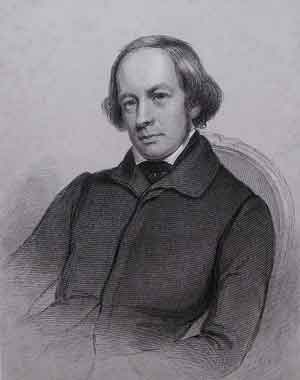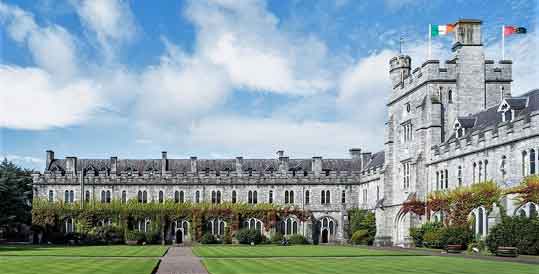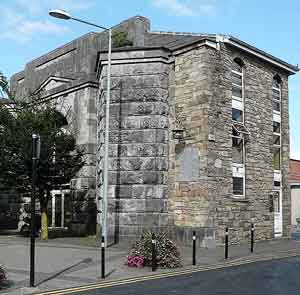‘QUEEN’S COLLEGE CORK IS IN FLAMES!’
Published in Features, Issue 2 (March/April 2023), Volume 31The curious case of Richard Burke, executed for murder, and the unsolved mystery of the great fire at Queen’s College, Cork, in 1862.
By Pat Poland
The fire at Queen’s College, Cork (QCC, later UCC), in May 1862, while not the largest, was certainly the most controversial blaze experienced in Cork in years, the repercussions from which would continue to smoulder long after the last glowing embers had been extinguished.
WHO WAS RESPONSIBLE?
There is no doubt that the fire was malicious. In the following weeks and months, the theories regarding the identity of the culprit(s) ranged from the sublime to the ridiculous, with each suspect shown to have had a motive, the wherewithal and the opportunity to carry out the deed. They included the college steward; a porter; Catholic priests; and, perhaps most bizarre of all, even the president of the college himself, 53-year old Sir Robert Kane. To compound the air of mystery, even the accused in a murder case was woven into the web of intrigue.
Sometime before six o’clock on the morning of Thursday 15 May 1862, just over the wall in the County Gaol, some warders noticed ‘a great smoke arising out of the west wing’ of the college and immediately raised the alarm. Sir Robert was asleep in his apartment a short distance across the quadrangle from the building on fire. Dressing hurriedly, he stepped out onto the lawn and could see the building opposite in flames, with the fire beginning to break through the roof.
The affected wing was (is) a large, two-storey, cut-stone building with a corridor running along its length on each floor, communicating on the west side with the various lecture rooms. Here were housed the chemistry, pathology and materia medica departments. It had a common roof void, unbroken by fire-stops, which allowed the fire to spread laterally very quickly. Architects had given no thought to the problems of internal fire spread or compartmentation.
HALF-CONSUMED MATCHES
In those pre-telephone days, the only means of summoning fire-fighting equipment from the city was either by runner or on horseback. While this was under way, some members of the college staff, including Sir Robert, warily entered the ground-floor corridor, where half-consumed matches were quickly discovered under each of the doors leading to the lecture rooms. The incipient fires had burned themselves out under three doors, but at the fourth, which led to the materia medica room (used to store pathological specimens preserved in flammable spirits), a substantial fire was in progress. As the fire took hold they made good their retreat.
News of the fire spread rapidly throughout the awakening city. In a pre-public fire service era, reliance was placed on a number of agencies for fire suppression. These included manual engines held by local industries, a small ‘brigade’ of men from the Corporation waterworks and the privately maintained engines of three insurance companies, the latter usually being the most effective.
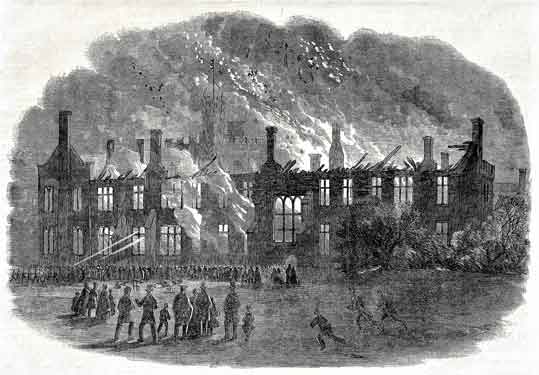
Above: ‘The Fire in the West Wing, Queen’s College Cork’ (Illustrated London News, 24 May 1862) and (below) the west wing today (from the opposite side).
The first engines to arrive were from Beamish and Crawford’s brewery and Perrott’s Iron Works, followed by the waterworks men. It soon became evident that fire precautions had a low priority on the college’s ‘to do’ list. No fire hydrants had been installed and no fire insurance had been effected on the complex. The result was an interminable delay in getting water on the blaze (the ground had to be dug up to expose the water main) and only one insurance fire-engine responded—some two hours after the initial alarm. By then it was too late to make a difference. With a final resounding crash, the remaining portions of the roof fell in and eventually the fire, sated, burnt itself out. The departments affected consisted principally of the materia medica, pathology, surgical and midwifery museums.
The fire in QCC was widely reported. The Illustrated London News carried the story in its edition of 24 May, accompanied by a depiction of the fire ‘spiritedly drawn’ by ‘Mr Stopford of Cork’. The House of Commons in London was awash with rumours about ‘the three train loads of explosives’ that had been taken right up against the walls of the college by republican dissidents to blow the place to smithereens. Mayor of Cork, MP and founder of the Cork Examiner John Francis Maguire, who was in the House, quickly scotched that absurdity. Now the hunt for the culprit(s) began. Later the same day, the authorities launched their investigation, a search that would take numerous twists and turns over the course of many months. Almost immediately, the spotlight fell on the staff themselves.
KANE’S TERM OF OFFICE MARRED BY DISPUTES
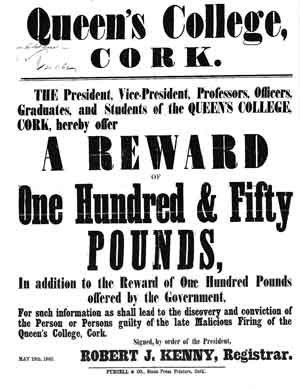
Above: Broadside offering a reward of £150 for information leading to the conviction of the perpetrator(s) of the fire. It was never claimed or awarded.
QCC first opened its doors to fee-paying students in 1849. Enjoying a handsome setting at the western edge of Cork, it is dominated by a wooded limestone precipice overlooking the Lee’s meandering south channel. Perched on the cliff top is the three-sided Gothic quad of white limestone quarried from the escarpment. The complex (for which the template appears to have been Magdalen College, Oxford) is the earliest large work of local architectural team Deane and Woodward, who went on to design the legendary Oxford Museum under the influence of John Ruskin. Building commenced as the effects of the disastrous potato blight were beginning to become manifest, and during the subsequent years of the Great Hunger the employment available proved a godsend to those desperately seeking work.
The term of office of Sir Robert Kane (a.k.a. the ‘Boy Professor’—he was just 22 when made Professor of Chemistry at the Apothecaries’ Hall, Dublin, in 1831) was marred by disputes with his peers—so much so that by 1865 almost half of the original professors had been dismissed or left of their own volition. Such a man had enemies waiting in the shadows, patiently biding their time for him to let his guard slip. To compound the fledgling college’s problems, the Roman Catholic Church was antagonistic towards the Queen’s Colleges, set up in Cork, Galway and Belfast. Regarded as ‘Godless places’, their form of organisation and character were felt to be out of accord with Catholic educational principles, and after a storm of public controversy they were condemned by the hierarchy. In 1847 the Holy See had condemned the Queen’s Colleges, with their ‘grievous and intrinsic dangers’.
In the feeding frenzy after the fire, for a time attention centred on two ‘ultramontane’ priests who had vehemently spoken out against the college system only two weeks previously. Or perhaps it was Williams, the steward, or Reynolds, the porter? All could be shown to have had the capacity to set the fire. The most outlandish claim of all, however, was made by a senior member of the academic staff, Professor Denis Brenan Bullen, who held the Chair of Surgery. The culprit, he intimated, was none other than the president himself, suggesting that Kane might have engineered the fire to divert attention from his many absences from his duties on campus, a major bone of contention among senior staff. Bullen, who desperately coveted the college presidency and (obviously) would go to extreme lengths to discredit Kane, must have taken momentary leave of his senses to make such an audacious claim, for under examination his contentions utterly collapsed. He later declared that he was completely mistaken, withdrew his accusations unreservedly and tendered his profound apology. The débâcle, not surprisingly, ended in his resignation in 1864 and almost ruined his professional reputation.
And what of the story of the man who was executed for the murder of his wife?
RICHARD BURKE
On the day after the fire in the college, the Cork Examiner carried a report with the headline ‘Committal of Mr Burke, Clerk of Waterford Union, on a charge of poisoning his wife’. This concerned the celebrated case of Richard Burke, who was later indicted at Clonmel assizes on 2 July 1862 for the murder of his wife, Johanna, and subsequently hanged.
Richard Burke was born at Rehill, between Cahir and Clogheen, Co. Tipperary, ‘of respectable parents of the farming class’. He had received a ‘superior English education’ and in 1847 became clerk of the Clogheen Union (i.e. workhouse), where he met his future wife, Johanna (née McGrath), a ‘woman of much intelligence’, whose father was a surveyor with the Duke of Devonshire at Lismore Castle estate. In 1850 Burke was appointed clerk of the Waterford Union, a significant promotion, and ‘with undeniable ability, discharged his duties from that time down to his arrest’.
On Tuesday 13 May 1862 an inquest was held at Clogheen, Co. Tipperary, into the death of Johanna Burke. Mrs Burke had died in agony at her home on the night of 14 April 1862, after taking some ‘medication’ sent to her from Waterford by her husband. In her dying moments, the unfortunate woman whispered to her sister, Alice, ‘Oh, Ally, Ally! God forgive them that caused it—God forgive them!’ It emerged that her husband was in a relationship with the schoolmistress of the Waterford Union.
STRYCHNINE
Evidence was heard from the local physician, Dr Walshe, that he had performed a post-mortem on the deceased on 15 April, detached her stomach and a small portion of her intestine, sealed them in a jar and given it to the police. Constable Hatton testified that he had brought the jar to Cork on 24 April and handed it over to Dr John Blyth, Professor of Chemistry at QCC. Blyth confirmed that he had received three items from Hatton: a bottle containing a fluid which was found to contain ‘harmless Essence of Turpentine’; a paper packet containing a white powder which he analysed as ‘a mixture of Epsom Salts, Carbonate of Magnesia and the deadly poison, Strychnine’; and the stomach and part of the intestine of the dead woman, contained in a jar with five seals. Strychnine was found in the viscera. Dr Blyth remarked that the items were deposited in his private laboratory in the college, in the West Wing. The jury withdrew and returned in a short time with their verdict: ‘That the deceased Johanna Burke came by her death from the effects of Strychnine, which she received from her husband, Richard Burke, from Waterford’. Burke was immediately arrested and transported to Clonmel Gaol.
Although Burke had been taken into custody, Dr Blyth’s forensic analysis had concluded and verbal evidence had been given at the inquest, the substantive evidence—the jar containing the dead woman’s stomach—still reposed in the doctor’s laboratory in the college. The conspiracy theorists argued that the accused might have had a slim chance of escaping the gallows if the damning evidence could be destroyed. The suggestion is that Burke, who apparently had ‘pleasing manners, a large amount of good nature and a warm readiness to oblige’, had a wide circle of friends, some of whom may have engineered the fire at the college in a last desperate bid to save him. They undoubtedly knew that the jar reposed in the doctor’s lab, for he had said as much at the inquest, but whether the short window of opportunity—from the proceedings on Tuesday to the early hours of Thursday morning—can be reconciled with the organising of an arson attack on the college is another matter. If, indeed, they did succeed, they must have been shocked to discover that their efforts were in vain, for Dr Blyth, only the very evening before the fire, had removed the jar from his laboratory and sent it to Waterford, as reported in the Cork Examiner on Saturday 17 May 1862.
On 24 July 1862 Richard Burke was found guilty and, in one of the last public hangings in Ireland, was executed on Monday 25 August in front of Clonmel Gaol.
PERPETRATOR(S) NEVER BROUGHT TO JUSTICE
Whoever was responsible for the fire at Queen’s College was never brought to justice. Many of the ordinary Cork people, to whom the college seemed a remote and arcane place, learnt of the fire with apathy and indifference. To them Queen’s College was an irrelevancy, associated with the ‘gentry’ and the ruling classes. In fact, in his report on the blaze Constable Goulden deposed that ‘amongst the lower order of people … there is no feeling of regret. Some say it is a pity any of the buildings escaped.’
The last word on this extraordinary episode in the annals of the college must surely go to Professor Rushton, head of History and English Literature. When in the aftermath of the blaze he was asked to report on the state of his department, his riposte was singularly apposite, concise and entirely fact-filled: ‘Burnt’.
Pat Poland is the author of For whom the bells tolled: a history of Cork Fire Services 1622–1900 (THP Ireland, 2010).
Further reading
British Parliamentary Papers, Vol. XLVI (1864), ‘Depositions taken before the Justices of the Peace, in the Case of the Burning of Queen’s College, Cork’.
J.A. Murphy, The College: a history of Queen’s/University College Cork 1845–1995 (Cork, 1995).
News Printing Works, The Clogheen poisoning case: being the sensational story of the trial of Richard Burke and one of the last public hangings in Ireland (Waterford, n.d., but c. 1898).










